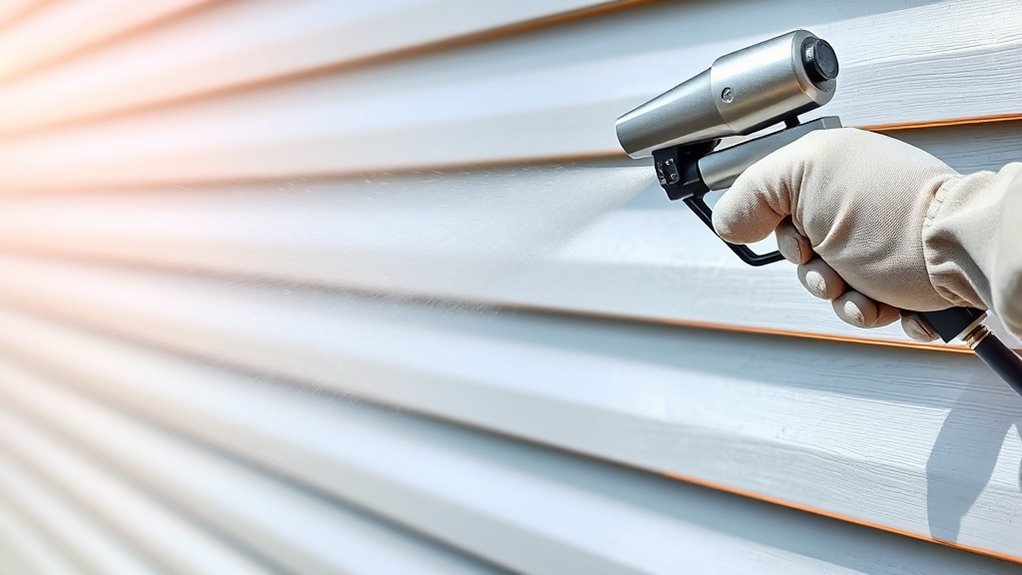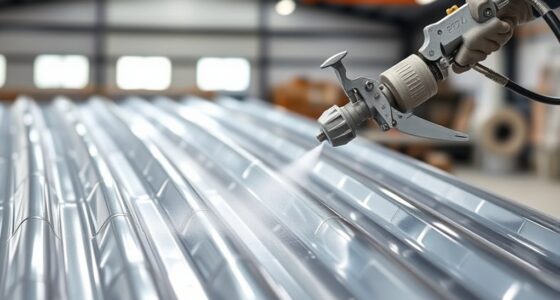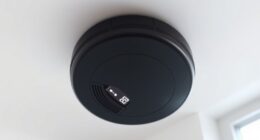To spray aluminum siding effectively, start by cleaning the surface thoroughly with a pressure washer to remove dirt, mold, and chalk. Inspect for loose paint and sand or scrape smooth. Apply a high-quality primer designed for metal surfaces with your spray equipment, keeping a consistent distance for an even coat. Choose a compatible paint, and use proper technique to guarantee a professional finish. Keep exploring for detailed steps to perfect your siding project.
Key Takeaways
- Clean siding thoroughly with a pressure washer and mild detergent, then allow it to dry completely.
- Scrape or sand loose or flaking paint for a smooth, clean surface before priming.
- Choose a high-quality primer compatible with aluminum and apply evenly with spray equipment.
- Match the spray equipment to the siding and paint type for smooth, even coating coverage.
- Follow primer manufacturer’s drying times before applying the topcoat for best adhesion.

Spraying aluminum siding is an effective way to refresh its appearance and protect it from the elements. Before you start, it’s vital to choose the right spray equipment and make certain the color matches your desired look. The spray equipment you select should be appropriate for siding projects—think HVLP (high-volume, low-pressure) sprayers or airless paint sprayers. These tools deliver a smooth, even coat and help you cover large areas efficiently. As you prepare to spray, take the time to find a paint color that matches or complements your existing exterior. Proper color matching guarantees your siding looks uniform and professional once finished. Many suppliers offer color-matching services, allowing you to bring a sample or specify a color code to get the perfect shade. This step can save you time and prevent costly mistakes down the line.
Once you’ve selected your spray equipment and color, you need to prep the siding properly. Start by cleaning the surface thoroughly to remove dirt, mold, and chalky residue. You can use a mild detergent or a specialized siding cleaner, and a pressure washer makes this task easier and more effective. After cleaning, let the siding dry completely. Any residual moisture can cause paint to bubble or peel later on. Next, inspect the siding for loose or flaking paint, and scrape or sand those areas to create a smooth, clean surface. This step helps the primer adhere better and results in a more durable finish. Additionally, understanding siding material characteristics can help determine the best cleaning and prep methods for optimal adhesion.
Priming is essential because it guarantees better paint adhesion and long-lasting color. Use a high-quality primer compatible with aluminum siding. Apply the primer evenly using your spray equipment, maintaining a consistent distance from the surface to avoid runs or drips. Follow the manufacturer’s instructions for drying times before moving on to the topcoat. Proper priming also helps to block any stains or discolorations from bleeding through the new paint. When selecting your primer, consider one formulated specifically for metal surfaces, as it will bond more effectively and provide a solid foundation for the color coat.
Throughout the process, keep the spray nozzle at a steady distance to ensure an even coat and prevent overspray. Consistency is key. Once primed and dried, you’re ready to move on to the actual painting, but this initial prep work—focused on correct color matching, choosing the right spray equipment, and thorough cleaning and priming—sets the foundation for a professional-looking finish that will last for years.
Frequently Asked Questions
Can I Spray Aluminum Siding in Rainy or Humid Conditions?
You shouldn’t spray aluminum siding in rainy or humid conditions because weather considerations can affect the paint’s adhesion and drying process. High humidity slows down drying, leading to uneven coverage or drips. Additionally, rain can wash away fresh paint. Before spraying, make certain your equipment is well-maintained and clean, as moisture can cause clogs. Wait for a dry, low-humidity day to achieve the best results and protect your investment.
What Safety Gear Should I Wear During Spraying?
Protect yourself properly by donning dependable protective gloves and a respirator mask. Safety first, so suit up before spraying to safeguard your skin from splatters and your lungs from harmful fumes. Wearing gloves keeps your hands clean and protected, while a respirator mask filters out airborne particles, preventing inhalation of dangerous chemicals. Prioritize your protection, and you’ll spray safely, smoothly, and successfully, ensuring a professional finish on your aluminum siding.
How Long Does the Primer Need to Dry Before Painting?
You should wait for the primer to dry completely before painting, which typically takes about 24 hours, depending on the primer’s drying time. During this period, guarantee proper ventilation to help it cure properly. Keep in mind that the paint curing duration can vary, but usually, you should allow at least 7 days before exposing the siding to harsh weather. Rushing this process may affect the final finish.
Is It Necessary to Remove Old Paint Before Spraying?
Did you know that improper surface preparation can cause paint failure in up to 60% of projects? You should definitely remove old paint before spraying aluminum siding. Paint removal guarantees a clean, smooth surface, which helps the new paint adhere better and last longer. Skipping this step can lead to peeling or bubbling, so take the time for proper surface prep to guarantee a professional, durable finish on your siding.
How Can I Prevent Drips and Uneven Coverage?
To prevent drips and uneven coverage, keep your spray gun at the right distance and use smooth, overlapping strokes. Avoid heavy application that causes drips. Use brush strokes or roller techniques to touch up any missed spots or uneven areas. Regularly check your work as you go, and maintain a steady hand. This approach helps achieve a uniform finish without drips or streaks, ensuring your siding looks professionally painted.
Conclusion
Now that you know how to prep and prime your aluminum siding, you might wonder if spraying actually makes it last longer than traditional brushing. Curiously, studies suggest that spray application can create a more even coat, potentially enhancing durability. So, next time you tackle this project, consider spraying—not just for a fresh look, but to give your siding the best chance to withstand the elements for years to come. Your home will thank you!
Franz came aboard the Paint Sprayer Zone team with a background in both journalism and home renovation. His articulate writing style, combined with a passion for DIY projects, makes him an invaluable asset. Franz has a knack for breaking down technical jargon into easy-to-understand content, ensuring that even the most novice of readers can grasp the complexities of paint sprayers.










